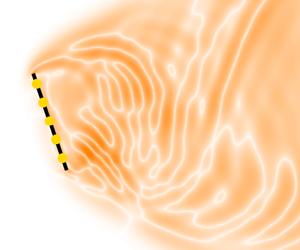Crossref Citations
This article has been cited by the following publications. This list is generated based on data provided by
Crossref.
Fukami, Kai
Nakamura, Taichi
and
Fukagata, Koji
2020.
Convolutional neural network based hierarchical autoencoder for nonlinear mode decomposition of fluid field data.
Physics of Fluids,
Vol. 32,
Issue. 9,
Qu, Jiagang
Cai, Weihua
and
Zhao, Yijun
2021.
Deep learning method for identifying the minimal representations and nonlinear mode decomposition of fluid flows.
Physics of Fluids,
Vol. 33,
Issue. 10,
Peng, Jiang-Zhou
Liu, Xianglei
Xia, Zhen-Dong
Aubry, Nadine
Chen, Zhihua
and
Wu, Wei-Tao
2021.
Data-Driven Modeling of Geometry-Adaptive Steady Heat Convection Based on Convolutional Neural Networks.
Fluids,
Vol. 6,
Issue. 12,
p.
436.
Benosman, Mouhacine
and
Borggaard, Jeff
2021.
Data-driven robust state estimation for reduced-order models of 2D boussinesq equations with parametric uncertainties.
Computers & Fluids,
Vol. 214,
Issue. ,
p.
104773.
Arzani, Amirhossein
Wang, Jian-Xun
and
D'Souza, Roshan M.
2021.
Uncovering near-wall blood flow from sparse data with physics-informed neural networks.
Physics of Fluids,
Vol. 33,
Issue. 7,
Carter, Douglas W.
De Voogt, Francis
Soares, Renan
and
Ganapathisubramani, Bharathram
2021.
Data-driven sparse reconstruction of flow over a stalled aerofoil using experimental data.
Data-Centric Engineering,
Vol. 2,
Issue. ,
Morimoto, Masaki
Fukami, Kai
and
Fukagata, Koji
2021.
Experimental velocity data estimation for imperfect particle images using machine learning.
Physics of Fluids,
Vol. 33,
Issue. 8,
Wu, Pin
Gong, Siquan
Pan, Kaikai
Qiu, Feng
Feng, Weibing
and
Pain, Christopher
2021.
Reduced order model using convolutional auto-encoder with self-attention.
Physics of Fluids,
Vol. 33,
Issue. 7,
Pawar, Suraj
San, Omer
Nair, Aditya
Rasheed, Adil
and
Kvamsdal, Trond
2021.
Model fusion with physics-guided machine learning: Projection-based reduced-order modeling.
Physics of Fluids,
Vol. 33,
Issue. 6,
Guastoni, Luca
Güemes, Alejandro
Ianiro, Andrea
Discetti, Stefano
Schlatter, Philipp
Azizpour, Hossein
and
Vinuesa, Ricardo
2021.
Convolutional-network models to predict wall-bounded turbulence from wall quantities.
Journal of Fluid Mechanics,
Vol. 928,
Issue. ,
Linot, Alec J.
and
Graham, Michael D.
2022.
Data-driven reduced-order modeling of spatiotemporal chaos with neural ordinary differential equations.
Chaos: An Interdisciplinary Journal of Nonlinear Science,
Vol. 32,
Issue. 7,
Zhong, Yonghong
Fukami, Kai
An, Byungjin
and
Taira, Kunihiko
2022.
Machine-learning-based reconstruction of transient vortex-airfoil wake interaction.
Fukami, Kai
An, Byungjin
Nohmi, Motohiko
Obuchi, Masashi
and
Taira, Kunihiko
2022.
Machine-Learning-Based Reconstruction of Turbulent Vortices From Sparse Pressure Sensors in a Pump Sump.
Journal of Fluids Engineering,
Vol. 144,
Issue. 12,
Jiang, Genghui
Kang, Ming
Cai, Zhenwei
Liu, Yingzheng
and
Wang, Weizhe
2022.
Data-driven temperature estimation of non-contact solids using deep-learning reduced-order models.
International Journal of Heat and Mass Transfer,
Vol. 185,
Issue. ,
p.
122383.
Otto, Samuel E.
and
Rowley, Clarence W.
2022.
Inadequacy of Linear Methods for Minimal Sensor Placement and Feature Selection in Nonlinear Systems: A New Approach Using Secants.
Journal of Nonlinear Science,
Vol. 32,
Issue. 5,
Jiang, Genghui
Kang, Ming
Cai, Zhenwei
Wang, Han
Liu, Yingzheng
and
Wang, Weizhe
2022.
Online reconstruction of 3D temperature field fused with POD-based reduced order approach and sparse sensor data.
International Journal of Thermal Sciences,
Vol. 175,
Issue. ,
p.
107489.
Manohar, Kevin H.
Morton, Chris
and
Ziadé, Paul
2022.
Sparse sensor-based cylinder flow estimation using artificial neural networks.
Physical Review Fluids,
Vol. 7,
Issue. 2,
Sitte, Michael Philip
and
Doan, Nguyen Anh Khoa
2022.
Velocity reconstruction in puffing pool fires with physics-informed neural networks.
Physics of Fluids,
Vol. 34,
Issue. 8,
Kumar, Yash
Bahl, Pranav
and
Chakraborty, Souvik
2022.
State estimation with limited sensors – A deep learning based approach.
Journal of Computational Physics,
Vol. 457,
Issue. ,
p.
111081.
Li, Songqi
Li, Wenpeng
and
Noack, Bernd R.
2022.
Machine-learned control-oriented flow estimation for multi-actuator multi-sensor systems exemplified for the fluidic pinball.
Journal of Fluid Mechanics,
Vol. 952,
Issue. ,


